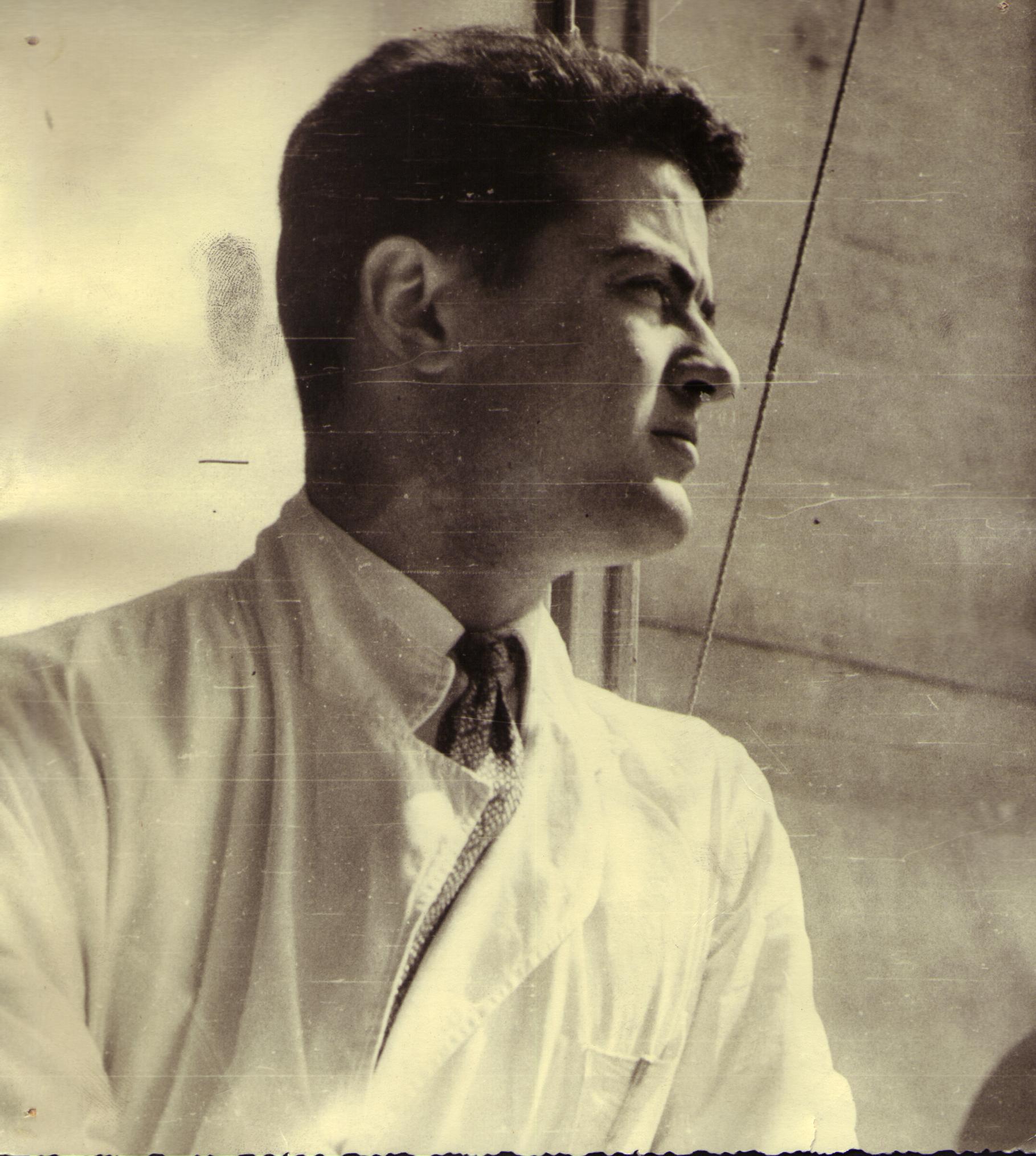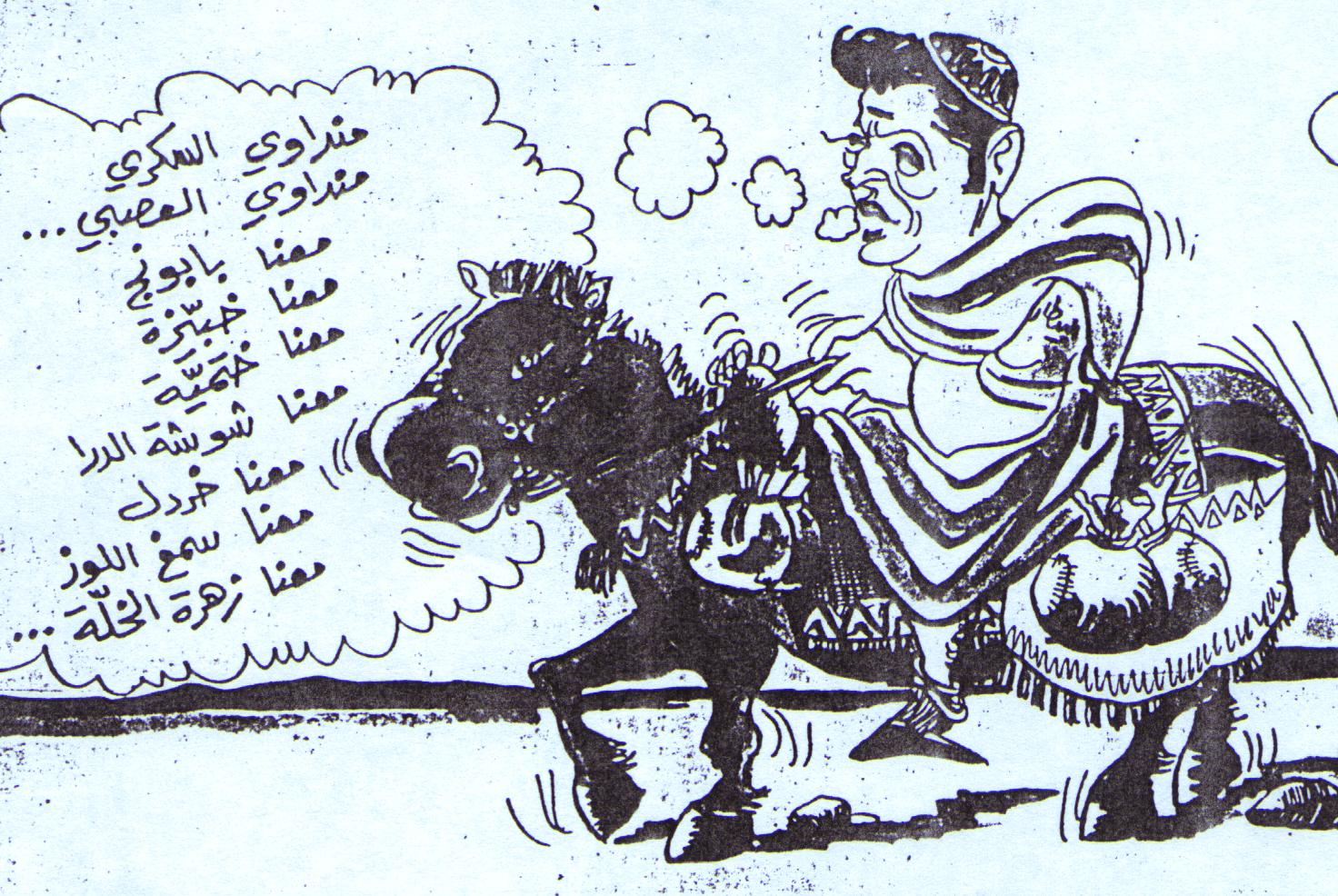|
Cette page retracera l'itinéraire professionnel d'Emile Bitar, en tant que médecin
et professeur de médecine. Elle incluera ses réflexions sur le métier médical, sur la relation singulère entre
le médecin et son patient.
Seront publiés sur cette page certains articles d'Emile Bitar parus dans des
revues médicales internationales.
| Montpellier, France, 1952 |

|
| Emile Bitar étudiant à la faculté en médecine |

|
| Vu par le caricaturiste Pierre Sadek |
"Utiliser des lieux communs pour évoquer
un homme hors du commun pourrait paraître inadéquat sinon inconvenant. Hors du commun,
Emile Bitar l'était à tous les niveaux et sous tous les aspects : ignorant superbement les intrigues, seul dans les luttes
sans merci où il fallait tenir tête aux puissances de l'argent et de la magouille. Idéaliste certes, mais son donquichottisme.(...)
A la Faculté, à l'Hôtel Dieu,
la même rigueur, la même droiture. Ne se contentant jamais de suivre les sentiers battus, il fut le créateur de l'Unité
de Recherche en Rhumatologie. Apprendre et publier, tels étaient ses mots d'ordre intangible, il représentait le Professeur,
l'Ami et le médecin, au sens le plus noble du terme.
Touché par la maladie, il est resté
debout jusqu'au dernier moment, altier sans orgueil, sans compromission, tombé au champ d'honneur quelques semaines avant
le Congrès Médecine et Méditerranée qu'il devait présider et qui devait consacrer son audience internationale et à travers
lui notre pays et notre Faculté.
Nous
pouvons dire "Mort, où est ta victoire ?", puisque d'Emile Bitar l'exemple demeurera et le souvenir. Impérissables.
Antoine
Ghossein,
Professeur
de médecine, Doyen de la faculté Française de Médecine
Professeur Edgar Gédéon, représentant la Faculté Française
de Médecine :
D'Emile Bitar le professeur, le chercheur et l'homme, émanaient
un esprit de sacrifice, de tendresse, de compassion. Il voyait dans le don se soi une véritable richesse et dans la transmission
du savoir l'une des plus nobles occupations.
Ce don de soi et cet esprit créatif dont Emile Bitar nous a fait
bénéficier durant les années où nous avons eu la chance de le côtoyer, nous espérons aujourdhui qu'ils continueront d'animer
cet hôpital qui va désormais porter son nom, afin que cet hôpital soit digne de lui, et soit porteur d'une espérance de vie,
une espérance de tous les jours, de tous les instants, qui permettra la continuité et la résistance de son esprit.
Emile Bitar - Bibliographie
(avec de chaleureux remerciements au Professeur Farid Sami Haddad)
1966 à 1990
1.- Bitar E. La goutte au liban. Lebanese Medical J. 19(5):235-41, 1966 Sep-Oct.
2.-
Bitar E. Chemali F. Gedeon EM. L'os cuboide: localisation rare de l'ostéome ostéoide.
Lebanese Medical Journal. 22(1):49-54, 1969.
3.- Bitar E. La polyarthrite chronique rhumatoide de l'adulte au Liban. Rev du Rhumatisme et des Maladies Osteo-Articulaires.
36(3):84-6, 1969 Mar.
4.- Bitar E.
La polyarthrite chronique rhumatoide de l'adulte au Liban: a propos de 125 cas. Lebanese Medical Journal. 22(3):311-7, 1969.
5.- Bitar E. Les medecins libanais
dans les pays arabes.
Lebanese Medical Journal. 22(5):653-6, 1969.
6.- Bitar E. La coxarthrose en pratique
rhumatologique au Liban.
Lebanese Medical Journal. 23(1):69-73, 1970.
7.- Naffah J. Bitar E. Nasr
W. Khoury K. Etude genetique de la polyserite paroxystique familiale. 72 cas. Nouvelle Presse Medicale. 4(14):1031-3, 1975
Apr 5. Abst: Study of the mode of hereditary transmission of familial paroxystic polyserositis in Lebanon led us to conclude
that the disease was transmitted in a dominant fashion. In almost one third of our families, dominant transmission was certain
or probable. In the other families, dominant heredity was not excluded if the hypothesis, supported by many facts, of incomplete
penetrance is accepted. The possibility that certain forms of the disease are dominant and others recessive cannot be rejected,
but in the absence of biological proff of this genetic heterogeneity it cannot be confirmed. The majority of the patients,
as is usual in the disease, were male. The highest risk groups in the Lebanese population are Armenians and Shiite Moslems
8.- Bitar E. Naffah J. Nasr W. Khoury
K. La maladie periodique (polyserite paroxystique familiale) a propos de 52 cas. Rev Rhumat et Malad Ostéo-Articulaires. 43(4):267-72,
1976 Apr. Abst: On the basis of well defined diagnostic criteria, the authors conclude that periodic disease affects males
in particular. It commences before the age of 20 years in 80 percent of cases. In particular it occurs in Armenian and Shiite
communities. Its evolution is normally benign ; amyloidosis is found in only 8 percent of cases. Joint manifestations are
found in 48 percent of cases and may take on different aspects and occur in several different sites : myaglia or arthralgia,
monoarthitis, oligoarthritis, polyarthritis, neck or sacroiliac pain. The authors have not noted prolonged peripheral joint
episodes. No cases of amyloidosis were diagnosed before the appearance of the clinical signs of the disease. An autosomal,
dominant heredity with incomplete penetration seems to be the most likely hypothesis.
9.- Bitar E. Rizk A. Nasr W. Gedeon EM. Tabbara W. Polyserite paroxystique familiale.
Complications peritoneales inedites. Une observation. Presse Medicale. 14(10):586-8, 1985 Mar 9. Abst: A young unmarried Lebanese
woman presenting with periodic disease (familial paroxysmal polyserositis) since she was 3 months old developed recurrent
abundant ascites at the age of 21 years. Several hundred millilitres of strongly eosinophilic fluid were evacuated. Exploratory
laparotomy unexpectedly disclosed an encapsulating peritonitis with adhesions involving the small bowel and the ascending
colon; there were masses of lipid-laden cells, clusters of cholesterol/crystals and marked mesoepithelial reaction. In view
of the patient's dramatic response to colchicine 2 mg/day, these findings were regarded as being related to the periodic disease.
10.- Bitar E. Ghayad E. Ghoussoub K.
Sinno W. Chams H. Khoury A. BaloglouP. Kallab K. Halaby C. Chemaly R. et al. La maladie de Behcet. A propos de 32 cas. Rev
Rhumat et Malad Ostéo-Articulaires. 53(11):621-4, 1986 Nov. Abst: The study of 32 cases of Behcet's disease has enabled the
authors to ascertain that the disease presents no particular characteristics in Lebanon, except certain variations in the
frequency of the symptoms. Their study includes two familial cases, or approximately 3 p. cent and confirms the severity of
these forms. Colchicine proves to be an effective treatment able to cure cutaneous and articular symptoms and perhaps stabilize
the ocular lesions. The long-term efficacy of steroid therapy in ocular manifestations is not certain. Chlorambucil caused
a stabilization of ocular lesions in four patients.
11.- Bitar E. Mohasseb G. Tabbara W. Jawish R. Chaftari R. Khayat G. A propos de l'ossification du ligament longitudinal
posterieur du rachis lombaire. Rev Rhumatisme et Malad Ostéo-Articul. 54(12):789-93, 1987 Dec. Abst: The authors present five
cases (4 men, 1 women) of ossification of the posterior lumbar longitudinal ligament. The mean age is 61 years. They emphasize
the extreme rarity of this location, its association with ankylosing spinal hyperostosis and diabetes in three patients; they
also give a reminder of the characteristics of this radiological symptom. They discuss the etiology on the basis of three
hypotheses (disc deterioration, hyperostosis, disease described by Japanese authors).
12.- Bitar E. Saliba G. Khoury K. Nasr W. Akatcherian C. Majdalani E. Vassoyan
J. Aoun JP. Ayoun SS. Tabet M. et al. Les manifestations musculaires de la maladie periodique. Rev Rhum et des Malad Ostéo-Articulaires.
55(4):261-3, 1988 Mar 15. Abst: Between 1976 and 1983, the authors studied 50 new patients affected with periodic disease.
16 of them-mean age: 29-presented muscular manifestations. They may be grouped into two clinical aspects: muscular pain and
contractures. The authors consider that these symptoms, first described in 1945, are an inherent part of the clinical picture
of the disease. They discuss their relationship with periarteritis nodosa and remind the fact that their pathogenesis remains
unknown.
13.- Mechelany E. Haddad F. Bitar
E. Kharrat K. Daou R. Chondromatose synoviale de la hanche. Annales de Chirurgie. 43(10):824-8,
1989. Abst: The authors report a case of synovial chondromatosis of the hip in physically active male adult operated on three
years ago and apparently cured. Review of the literature shows that the diagnosis, essentially based on X-ray examination,
bonescan and arthrography, needs to be confirmed by histological examination. Treatment must be surgical and must be carried
out as soon as possible to prevent arthrosis. Surgery should include thorough excision of the synovial membrane and a curettage
of the acetabular fossa to avoid recurrence. Under these conditions, prognosis appears to be excellent.
14.- Mechelany E. Haddad F. Bitar E. Kharrat K. Daou R. Chondromatose synoviale de la hanche. Annales de Radiologie. 33(4-5):284-8, 1990. Abst: The authors
report a case of synovial chondromatosis of the hip in physically active male adult operated on three years ago and apparently
cured. Review of the literature shows that the diagnosis, essentially based on X-ray examination, bone-scan and arthrography,
needs to be confirmed by histological examination. Treatment must be surgical and must be carried out as soon as possible
to prevent arthrosis. Surgery should include thorough excision of the synovial membrane and a curettage of the acetabular
fossa to avoid recurrence. Under these conditions, prognosis appears to be excellent.
|



